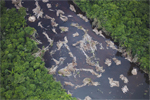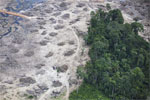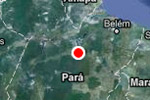
The image was a collaboration between aerial artist John Quigley and a committee of indigenous peoples including Aldamir Sataré-Mawé (Amapá), Sheyla Juruna (Pará), Dione Vison Terena (Mato Groso do Sul), Augusto Kaigamg (Rio Grande do Sul), and Capitao Potuguara. Image courtesy of Amazon Watch.
Nearly 1500 people formed a human banner on a beach in Rio de Janeiro today to protest plans to build dozens of dams in the Amazon basin, reports Amazon Watch, an NGO campaigning against Brazil’s controversial Belo Monte dam.
The image depicted a first nations member reaching toward the sun and included text reading “Rios para a vida” (“Rivers for life”). Organizers say the display “symbolized the important role of indigenous knowledge and a strong preference for meeting our collective energy needs through renewable sources like solar power”.
“Rivers should be dedicated to supporting the life of the millions of humans who depend on them and … should remain undammed,” stated a press release issued by Amazon Watch, Articulation of Brazilian Indigenous Peoples, the Global Campaign for Climate Action, and the Rainforest Action Network.
The action especially targeted the Belo Monte dam, which has become a sore point for Brazil as it hosts the Rio+20 Earth Summit. Belo Monte will flood tens of thousands of hectares of rainforest, displacing thousands of people and blocking important fish migration routes, potentially disrupting livelihoods of large numbers of river-dependent communities.
“We want to tell the world that the rivers, people and the planet need to be saved. The message of the banner is that we can live more sustainably, respecting the Earth’s people and without destroying its natural resources,” said indigenous leader Sheyla Juruna in a statement. Juruna’s community may be forced to move when the dam becomes operational.
Brazil intends to build some 60 hydroelectric projects in the Amazon region in coming decades. The government says the dams represent a source of clean, renewable energy, but critics maintain the damage they cause outweigh the benefits. Tropical dams emit large amounts of carbon in the form of methane, according to scientists.
Related articles
Protesters dig canal through Belo Monte dam in Brazil (Photos)
(06/16/2012) In an symbolic protest of the giant Belo Monte Dam, Friday morning some 300 locals dug a channel in an earthen dam that blocks a portion of the Xingu River and serves as the first step of the controversial hydroelectric project, reports Amazon Watch.
Tropical dams are a false solution to climate change
(05/27/2012) Tropical dams emit considerably more greenhouse gas emissions than their temperate counterparts yet are being treated as a solution to climate change, warns a report published in Nature Climate Change.
Will mega-dams destroy the Amazon?

(04/18/2012) More than 150 new dams planned across the Amazon basin could significantly disrupt the ecological connectivity of the Amazon River to the Andes with substantial impacts for fish populations, nutrient cycling, and the health of Earth’s largest rainforest, warns a comprehensive study published in the journal PLoS ONE. Scouring public data and submitting information requests to governments, researchers Matt Finer of Save America’s Forests and Clinton Jenkins of North Carolina State University documented plans for new dams in Bolivia, Brazil, Colombia, Ecuador, and Peru.
Pictures: Destruction of the Amazon’s Xingu River begins for Belo Monte Dam

(04/18/2012) The Xingu River will never be the same. Construction of Belo Monte Dam has begun in the Brazilian Amazon, as shown by these photos taken by Greenpeace, some of the first images of the hugely controversial project. Indigenous groups have opposed the dam vigorously for decades, fearing that it will upend their way of life. Environmentalists warn that the impacts of the dam—deforestation, methane emissions, and an irreparable changes to the Xingu River’s ecosystem—far outweigh any benefits. The dam, which would be the world’s third largest, is expected to displace 16,000 people according to the government, though some NGOs put the number at 40,000. The dam will flood over 40,000 hectares of pristine rainforest, an area nearly seven times the size of Manhattan.
Belo Monte Dam: A spearhead for Brazil’s dam-building attack on the Amazon?

(03/23/2012) Brazil’s Belo Monte Dam on the Xingu River is now under construction despite its many controversies. The Brazilian government has launched an unprecedented drive to dam the Amazon’s tributaries, and Belo Monte is the spearhead for its efforts. Brazil’s 2011-2020 energy-expansion plan calls for building 48 additional large dams, of which 30 would be in the country’s Legal Amazon region1. Building 30 dams in 10 years means an average rate of one dam every four months in Brazilian Amazonia through 2020. Of course, the clock doesn’t stop in 2020, and the total number of planned dams in Brazilian Amazonia exceeds 60.